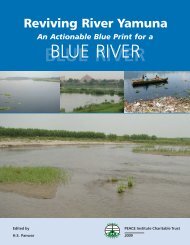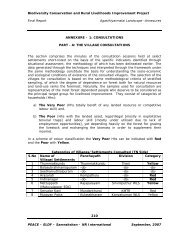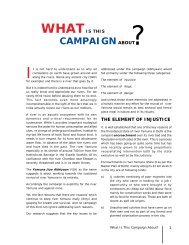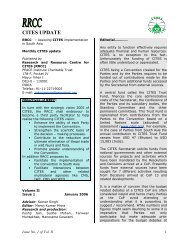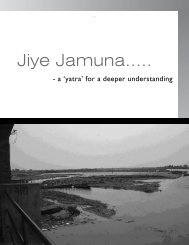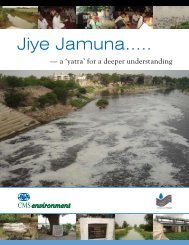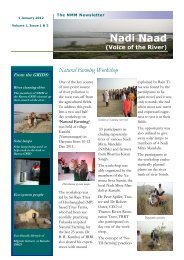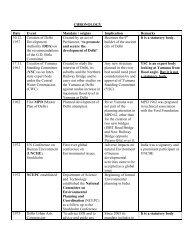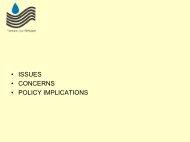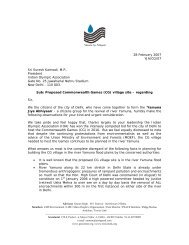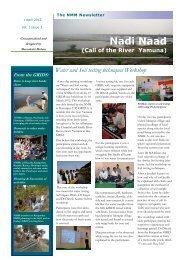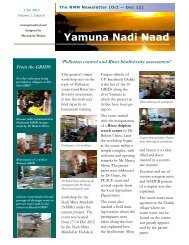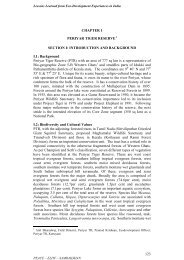4 - PEACE Institute Charitable Trust
4 - PEACE Institute Charitable Trust
4 - PEACE Institute Charitable Trust
You also want an ePaper? Increase the reach of your titles
YUMPU automatically turns print PDFs into web optimized ePapers that Google loves.
Objectives of RRCC:<br />
In tune with the strategic<br />
vision 2008-<br />
2013 of CITES, the<br />
RRCC endeavours as<br />
a third party facilitator<br />
to help realize the<br />
following twofold purpose<br />
of the strategic<br />
vision:<br />
• to improve the<br />
working of the Convention,<br />
so that international<br />
trade in wild<br />
fauna and flora is<br />
conducted at sustainable<br />
levels; and<br />
• to ensure that<br />
CITES policy developments<br />
are mutually<br />
supportive of international<br />
environmental<br />
priorities and take<br />
into account new international<br />
initiatives,<br />
consistent with the<br />
terms of the Convention<br />
In carrying out the<br />
above mentioned objectives,<br />
the RRCC<br />
wishes to:<br />
•Facilitate the implementation<br />
of the<br />
Convention in South<br />
Asia<br />
• Promote interactions<br />
between CITES<br />
and other related<br />
multilateral agencies<br />
like CMS, IWC, CBD,<br />
WTO, WCO, INTER-<br />
POL etc<br />
CITES Update<br />
V O L U M E 7 , I S S U E 4<br />
RRCC – Assisting CITES implementation in South Asia<br />
Monthly CITES Update<br />
Advisor: Samar Singh<br />
Editorial…..<br />
Editor: Manoj Kumar Misra<br />
Research and Production: Pushp Jain, Sudha Mohan, Manorama Goswami<br />
Published by<br />
Research and Resource Centre for CITES (RRCC)<br />
<strong>PEACE</strong> <strong>Institute</strong> <strong>Charitable</strong> <strong>Trust</strong><br />
178-F, Pocket IV, Mayur Vihar I<br />
DELHI – 110091, INDIA<br />
Telefax: 91-11-22719005<br />
E-mail: manojmisra@peaceinst.org<br />
April, 2011<br />
Regulation of trade in plant specimens covered under the provisions of<br />
CITES is far more complex than the trade in animal specimens. This is because<br />
of the great number as well as the variety in species as well as the<br />
parts and products in which a plant species could get traded. The above is<br />
further compounded by a difficulty in identification of a plant specimen and<br />
a general lack of trained staff with requisite identification skills. The result<br />
of such a situation can on one hand endanger further a highly traded species<br />
already in trouble and on the other specially in the case of<br />
a medicinal plant in trade make the medicine/s thus produced of dubious<br />
efficacy or even toxic in nature.<br />
In a case study on ‘Indian Medicinal Plants in Trade’ by Dr. H B Singh of<br />
Raw Materials Herbarium & Museum (RHMD), New Delhi, published in the<br />
Medherb Green Pages 2009 it was reported that:<br />
“In the present study it has been observed that out of 3076 crude drug<br />
samples, received for identification, 345 samples were found to be spurious.<br />
They have been either the allied species of the genuine one or the<br />
mixtures of the two or all together different plants belonging to different<br />
families. The medicines prepared from these spurious drugs may not be<br />
therapeutically as effective as prepared by genuine one because it may not<br />
have the same active ingredient. Moreover, they may contain toxic compounds<br />
which may cause deleterious effect on human health”.<br />
The situation as above indicates of the challenges involved in effective and<br />
efficient regulation of international trade in plant specimens covered by the<br />
provisions of CITES. One of the ways for the same is to produce and widely<br />
disseminate user friendly identification manuals. It may be noted that the<br />
1
C I T E S U P D A T E<br />
CITES secretariat as well as some of the Parties have produced such identification manuals. In this context,<br />
the CITES Wiki Species Identification manual, available at www.cites.org is a welcome effort. A<br />
search at the same, which is otherwise free to a user, points to the challenges involved in such an effort.<br />
It may be noted that an identification manual without suitable pictures to aid identification is of limited<br />
use and thus the CITES manual has still a long way to go to become a truly standard source (as many<br />
sheets are primarily text) for aiding quick and reliable identification of a specimen in hand with a custom<br />
or a wildlife official with little technical education. A CITES species photo gallery at http://www.cites.org/<br />
index.html is again of limited utility as it lists few species. In this context PC19 Doc 19 (we carry the details<br />
elsewhere in the issue) prepared for the 19 th meeting of the Plants Committee (PC) scheduled from<br />
18-21 April 2011 at Geneva (Switzerland) is relevant.<br />
A recently uploaded ‘manual on wildlife species in trade’ on the official website (http://moef.nic.in/<br />
index.php#) of the Ministry of Environment and Forest, MOEF, India is a laudable initiative which is worthy<br />
of replication by other countries and CITES Parties in the region and beyond.<br />
The CITES secretariat has announced two vacancies in its Enforcement support division. Eligible candidates<br />
from the Parties in the south Asia region may like to apply through http://careers.un.org for the<br />
same.<br />
Happy reading……<br />
Manoj Misra<br />
PC19 Doc. 19<br />
Nineteenth meeting of the Plants Committee Geneva (Switzerland), 18-21 April 2011<br />
PROGRESS REPORT ON THE IDENTIFICATION MANUAL<br />
1. This document has been prepared by the Secretariat.<br />
2. In accordance with Resolution Conf. 11.19, paragraph g), the Secretariat herewith provides a report<br />
on the progress made with the production of the Identification Manual.<br />
3. The Identification Manual is one of the Convention’s longest-running initiatives, having been initiated<br />
in 1977. The manual now exists as the CITES Wiki Identification Manual, completing the transition<br />
between the original paper-based version to a Web-based database.<br />
4. Access to the database is open to all users. Users who wish to add identification content, or modify<br />
existing content, must first register through the CITES Wiki Identification Manual. Once registered,<br />
users can apply to be content editors by sending a request by email to the Identification Manual administrator,<br />
with a brief indication of their areas of interest and expertise. Only information on identification<br />
characteristics can be added to or modified within the CITES Wiki Identification Manual. All<br />
additions and changes are subject to review before appearing in the Manual, and they are attributed<br />
to the submitter.<br />
2
C I T E S U P D A T E<br />
5. At the time of writing (January 2011), there were 275 registered users, 15 of whom had requested<br />
editing rights. Edits had been made to 34 sheets (mostly additions to ORCHIDACEAE). A new sheet<br />
for Lodoicea maldivica, included in Appendix III at the request of Seychelles, had been prepared and<br />
added to the database by the Department of Environment of Seychelles and the Seychelles Islands<br />
Foundation. The Secretariat is grateful to the Government of Seychelles and to the expert contributors<br />
for these important contributions.<br />
6. The first year of use of the CITES Wiki Identification Manual has helped identify areas where the database<br />
needs improvement and modification, such as speed and ease of use, providing linkages to<br />
other CITES resources and making available taxonomic group descriptions, keys and other general<br />
information. The Secretariat has explored the possibility of making the database usable on hand-held<br />
devices and is seeking funds to make these and other improvements, so as to develop the database<br />
as an easily-accessible and practical identification resource.<br />
7. The Secretariat invites Parties, organizations and experts to contribute content to the CITES Wiki<br />
Identification Manual, available at http://www.cites.org/eng/resources/wiki_id.shtml.<br />
8. The Committee is invited to note this report.<br />
NEWS<br />
ICCWC begins its work<br />
(http://www.cites.org/eng/news/sundry/2011/20110301_ICCWC.shtml)<br />
The Senior Experts Group of the International Consortium on Combating Wildlife Crime (ICCWC) met last<br />
week at the United Nations Office on Drugs and Crime (UNODC) in Vienna, Austria.<br />
Opened by Mr Yury Fedotov, Executive Director of UNODC, the meeting provided an opportunity for specialized<br />
staff of the five partner agencies to plan ICCWC activities in the short and mid-term.<br />
Experts agreed to develop a comprehensive programme of work. This programme will exploit the expertise<br />
of the agencies and target organized crime associated with the illegal trade in endangered species.<br />
Whilst some efforts may be designed around the trade in high-profile species, such as elephants, rhinoceros,<br />
snow leopards and tigers, the Consortium’s activities will not be only species-specific. Similarly, although<br />
some specific trafficking routes, such as those from Africa to Asia, will receive special attention,<br />
ICCWC will operate at a global level.<br />
The Consortium committed to the following in 2011:<br />
• A senior-level seminar involving Customs and the police from the 13 countries in Asia where tigers<br />
are still found in the wild;<br />
• Supporting the CITES Ivory and Rhinoceros Enforcement Task Force in bringing together law enforcement<br />
officials from countries affected by illegal trade in elephant and rhinoceros parts and products,<br />
to design strategies to combat such trade and facilitate the exchange of intelligence about those involved;<br />
• Providing training support to officials in the recently-established South Asia Wildlife Enforcement Network;<br />
and<br />
• Completing a toolkit on Wildlife and Forest Crime, which countries can use to review their current response<br />
to such crimes (noting 2011 is the International Year of Forests).<br />
3
C I T E S U P D A T E<br />
The largest project for 2011, however, will be a programme to establish Controlled Delivery Units in<br />
countries affected by trafficking in wildlife, especially illegal logging. In a pilot phase, this will offer capacity<br />
building to Customs, the police and prosecutors from about 20 countries in Africa and Asia, so that<br />
they can quickly respond to illegal shipments that are detected whilst being transported from one country<br />
to another, and one continent to another. The project will also seek to guide national law enforcement<br />
agencies to follow the money throughout the criminal chain, targeting the profits of organized crime<br />
groups and networks.<br />
John M. Sellar, Chief of Enforcement Support in the CITES Secretariat, who chaired the ICCWC meeting,<br />
said: “The senior experts are excited by the opportunities that the Consortium provides to help countries<br />
bring to justice those criminals who seek to rob countries of their natural resources and exploit local<br />
communities in some of the world’s poorest nations. ICCWC is an unprecedented attempt to ‘mainstream’<br />
the fight against wildlife crime, by interacting with relevant officials throughout the whole criminal justice<br />
system. CITES is proud and honoured to be collaborating with colleagues from international intergovernmental<br />
organizations, who bring decades of experience and who are respected worldwide in their specialized<br />
fields of work.”<br />
CITES NOTIFICATIONS<br />
(Here we carry the operational part of Notifications issued by the CITES Secretariat that bear relevance to the Parties in South Asia<br />
– Editor)<br />
Notification No. 2011/020 Geneva, 23 February 2011<br />
CONCERNING: Job openings<br />
1. The Secretariat hereby transmits to the Parties details of two job openings for the posts of Senior<br />
Programme Officer (Chief of Enforcement Support) and Programme Officer (Enforcement Support Officer)<br />
within the Secretariat. The first post will become vacant in September this year upon the retirement<br />
of the current Chief of Enforcement Support. The second post results from a budgetary decision<br />
taken at the 15th meeting of the Conference of the Parties (Doha, 2010), which was planned to take<br />
effect in 2012. However, the Secretariat has been able to identify funding to allow recruitment to take<br />
place this year.<br />
2. The Management and Enforcement Authorities of the Parties are requested to provide copies of the<br />
attached documents to potential candidates for these posts.<br />
3. Applications for these posts should be made through the United Nations on-line INSPIRA system, accessed<br />
via the following link: http://careers.un.org.<br />
Notification No. 2011/021 Geneva, 24 February 2011<br />
CONCERNING: CITES and National Biodiversity Strategies and Action Plans under the Convention on Biological<br />
Diversity<br />
1. The present Notification to the Parties has been prepared by the CITES Secretariat in consultation with<br />
the Secretariats of the Convention on Biological Diversity (CBD) and of the Global Environment Facility<br />
(GEF).<br />
4
C I T E S U P D A T E<br />
2. The CITES Strategic Vision: 2008-2013 comprises three interrelated goals. Goal 3 is to “Contribute to<br />
significantly reducing the rate of biodiversity loss by ensuring that CITES and other multilateral instruments<br />
and processes are coherent and mutually supportive.” In addition, the Memorandum of<br />
Cooperation between the CITES and CBD Secretariats states that “the secretariats will consult their<br />
Contracting Parties with a view to encouraging integration and consistency between national strategies,<br />
plans or programmes under the Convention on Biological Diversity and plans or programmes<br />
under the Convention on International Trade in Endangered Species of Wild Fauna and Flora.”<br />
3. The secretariats of the biodiversity-related conventions have been working together to help Parties<br />
achieve a more coherent and mutually supportive implementation of the conventions at the national<br />
level.<br />
4. At its 10th meeting (Nagoya, 2010), the Conference of the Parties to CBD adopted a number of Decisions<br />
that are of relevance to the implementation of CITES plans and programmes.<br />
5. In Decision X/2, the CBD Conference adopted a Strategic Plan for Biodiversity 2011-2020 and the Aichi<br />
Biodiversity Targets which it recognizes as "a useful flexible framework that is relevant to all biodiversity-related<br />
conventions". In paragraph 3) of this Decision, the CBD Conference urges CBD Parties<br />
to develop national targets in line with the Strategic Plan and to update their national biodiversity<br />
strategies and action plans (NBSAPs), where appropriate. Moreover, in subparagraph 3 (f), it urges<br />
CBD Parties to:<br />
Support the updating of national biodiversity strategies and action plans as effective instruments to<br />
promote the implementation of the Strategic Plan and mainstreaming of biodiversity at the national<br />
level, taking into account synergies among the biodiversity-related conventions in a manner consistent<br />
with their respective mandates.<br />
6. Furthermore, in paragraph 3 of Decision X/5 on Implementation of the Convention and the Strategic<br />
Plan, the CBD Conference invites CBD Parties to:<br />
involve national level focal points of all the biodiversity-related agreements, as appropriate, in the<br />
process of updating and implementation of national biodiversity strategies and action plans and related<br />
enabling activities.<br />
7. Finally, in paragraph 7. c) of the same Decision, it requests the CBD Executive Secretary, subject to<br />
the availability of resources, to:<br />
collaborate with the secretariats of other biodiversity-related conventions to facilitate the participation<br />
of national focal points of these agreements, as appropriate, in the updating and implementation of<br />
national biodiversity strategies and action plans and related enabling activities.<br />
8. With the support of Japan and other donors, the CBD Secretariat is organizing a series of regional or<br />
sub-regional workshops to: assist Parties in updating their NBSAPs, including development of national<br />
targets; help facilitate national implementation of the Strategic Plan for Biodiversity 2011-2020; and<br />
translate the Strategic Plan into national targets and commitments. The workshops will be announced<br />
by the CBD Secretariat, with the first one being a workshop for southern Africa on 14-20 March 2011,<br />
in Kasane (Botswana).<br />
9. Activities identified in the NBSAPs of developing countries and countries with economies in transition<br />
will be better placed to attract financial resources, especially from GEF, the financial mechanism of<br />
the CBD. The GEF provides financial resources to country-driven projects and activities that are<br />
aligned with COP decisions, the GEF biodiversity strategy and that are prioritized in NBSAPs.<br />
5
C I T E S U P D A T E<br />
10. When revising and updating their NBSAPs, Parties are therefore invited to consider integrating national<br />
and regional CITES activities that contribute to the effective implementation of the Strategic<br />
Plan for Biodiversity 2011-2020 and the Aichi Biodiversity Targets, and the conservation and sustainable<br />
use of wild fauna and flora, as appropriate.<br />
11. CITES Management Authorities are encouraged to engage directly with the national CBD focal point<br />
in advance of the workshop, and throughout the process of updating NBSAPs, in order to explore possibilities<br />
of their participation in the workshops, where appropriate, and to identify relevant CITES activities<br />
that could be included into the revised and updated NBSAPs. The contact details of national<br />
CBD focal points can be found at www.cbd.int/information/nfp.shtml.<br />
12. Further information on the workshops is available from the CBD website at www.cbd.int/nbsap or on<br />
the CITES calendar at http://www.cites.org/eng/news/calendar.shtml.<br />
13. The CITES Secretariat is preparing practical guidance on integrating CITES commitments into<br />
NBSAPs and on developing GEF project proposals, which it will circulate in a future Notification.<br />
Notification No. 2011/022 Geneva, 24 February 2011<br />
CONCERNING: CITES contribution to the National Portfolio Formulation Exercise of the Global Environment<br />
Facility<br />
1. This Notification has been prepared by the CITES Secretariat in consultation with the Secretariat of the<br />
Global Environment Facility (GEF).<br />
2. The GEF is the financial mechanism of the Convention on Biological Diversity (CBD). It provides financial<br />
resources to Parties for activities that are included in the National Portfolio Formulation Exercises<br />
(NPFEs). The NPFEs are designed to enable the eligible countries to select the projects for GEF resource<br />
programming covering the GEF-5 period. NPFEs are currently on-going for the fifth replenishment<br />
period of the GEF (2010-2014).<br />
3. Activities related to the protection of certain species of wild fauna and flora against over-exploitation<br />
through international trade could be included in these NPFEs, if they are a priority for the country.<br />
Projects and programmes for sustainable use and conservation of species of wild fauna and flora that<br />
generate global environmental benefits identified during the NPFE of a country may be relevant for<br />
the further implementation of Resolution Conf. 10.4 (Rev. CoP14) and CITES Strategic Vision: 2008-<br />
2013, and alignment of its goals into GEF-funded activities.<br />
4. The Biodiversity Strategy for GEF-5 includes in its five strategic objectives many of the same targets<br />
and activities as identified in the CITES Strategic Vision: 2008-2013. More information on the GEF<br />
Biodiversity Strategy is available from the GEF focal points.<br />
5. Parties are encouraged to proactively engage with their GEF operational focal points during prioritysetting<br />
consultations. The list of GEF Focal Points is available on the GEF website at http://<br />
www.thegef.org/gef/focal_points_list. Please contact them if interested to attend the NPFE consultations<br />
or gain further information on the GEF-funded activities in their country.<br />
6. Parties' attention is also drawn to Objective Five of the Biodiversity Strategy for GEF-5 that has set<br />
aside funds to support NBSAPs. More information is available from the GEF focal points.<br />
7. Further information on the NPFEs can be found on the GEF website (http://www.thegef.org/gef/<br />
National_Portfolio_Formulation_Exercises) and further information on NBSAPs on the CBD website at<br />
www.cbd.int/nbsap.<br />
6
C I T E S U P D A T E<br />
Notification No. 2011/023 Geneva, 7 March 2011<br />
CONCERNING: Transport of live specimens<br />
1. At its 15th meeting (CoP15, Doha, 2010), the Conference of the Parties adopted Decision 15.59 on<br />
Transport of live specimens which provides that:<br />
The Animals and Plants Committees, in consultation with the Secretariat, should:<br />
a) proceed with replacing the CITES Guidelines for transport and preparation for shipment of wild animals<br />
and plants (1981) with new guidelines for non-air transport of live animals and plants for consideration<br />
at the 16th meeting of the Conference of the Parties (CoP16);<br />
b) consult and liaise with relevant transport experts and other stakeholders, inter alia, to gather information<br />
related to non-air transport;<br />
c) review and propose revisions to Resolution Conf. 10.21 (Rev. CoP14) and Resolution Conf. 12.3 (Rev.<br />
CoP15) for consideration at CoP16; and<br />
d) report on the implementation of this decision at CoP16.<br />
2. To facilitate the work of the Animals and Plants Committees under Decision 15.59, Parties are invited<br />
to provide the Secretariat with:<br />
a) any available legislation, guidelines, codes of conduct or other information on transport standards related<br />
to non-air transport; and<br />
b) contact information for any identified experts on non-air transport of CITES-listed species.<br />
3. Parties are encouraged to provide, at their earliest convenience and preferably by 31 August 2011, the<br />
information described in paragraph 2 above. Parties are welcome to contribute as well any experience,<br />
views or ideas that might help with the effective implementation of Decision 15.59.<br />
CITES CALENDAR<br />
(We carry here information about such events in the CITES calendar which directly impact or relate to the CITES Parties in South<br />
Asia region - Editor)<br />
11-14 April 2011: CITES Asian snake trade workshop, Guangzhou, China<br />
15-19 April 2011: Regional workshop for Europe on updating National Biodiversity Strategies and Action<br />
Plans, Isle of Vilm, Germany<br />
17 April 2011: Deadline for submission of applications for the post of Chief of Enforcement Support (see<br />
Notification to the Parties No. 2011/020)<br />
18-21 April 2011 - 19th meeting of the CITES Plants Committee, Geneva, Switzerland<br />
23 April 2011: Deadline for submission of applications for the post of Enforcement Support Officer (see<br />
Notification to the Parties No. 2011/020)<br />
7
C I T E S U P D A T E<br />
9-16 May 2011: Regional workshop for east, south and southeast Asia on updating National Biodiversity<br />
Strategies and Action Plans, Xi'an, China<br />
14-18 May 2011: Second International Marine Conservation Conference (Symposium: Integrating science<br />
and policy: how scientists can help CITES advance marine conservation). Victoria, Canada<br />
17-20 May 2011: Symposium: The relevance of community-based natural resource management<br />
(CBNRM) to the conservation and sustainable use of CITES-listed species in exporting countries. Agenda<br />
and Terms of Reference for the Working Groups. Vienna, Austria<br />
19 May 2011: Deadline for the submission of documents for consideration at the 25th meeting of the<br />
CITES Animals Committee<br />
24-26 May 2011: Meeting of the Standing Committee Working Group on Introduction from the Sea, Bergen,<br />
Norway<br />
16 June 2011: Deadline for the submission of documents for consideration at the 61st meeting of the<br />
CITES Standing Committee<br />
18-22 July 2011: 25th meeting of the CITES Animals Committee, Geneva, Switzerland<br />
15-19 August 2011 - 61st meeting of the CITES Standing Committee, Geneva, Switzerland<br />
NOTABLE SEIZURES<br />
(We carry here relevant information on recent seizures of wildlife items from countries in South Asia region – Editor)<br />
2 smugglers held with tiger skins (The Pioneer, New Delhi, 6 March 2011)<br />
Loni police have arrested two smugglers with two skins of tigers. The value of the skins in the international<br />
market is assessed to be at Rs 2 lakh.<br />
The police said during vehicular checking at Karawal Nagar check post under Loni police station on Friday,<br />
the police found two persons roaming in suspicious ways.<br />
Soon the police took them under their custody. During interrogation, they revealed that they were waiting<br />
for a person to get their articles smuggled into Delhi. The person had promised to pay Rs 2 lakh if the<br />
articles are smuggled safely into Delhi territory. They revealed their names as Om Pal and Raju both residents<br />
of Amar Colony Delhi.<br />
The police recovered the two tiger like skins from their possession whose market price are assessed at Rs<br />
2 lakh.<br />
"We have arrested them under wildlife protection Act and further investigation is going on to arrest their<br />
counterparts in Delhi," said Superintendent of Police (City) JK Shahi.<br />
NB: We would like to mention that we report seizures and news as they are reported in the media. While we do try to ascertain the<br />
correctness of the reports that we carry, we do not take any responsibility for the correctness or otherwise of the information as it<br />
is put out by the newspapers. We would nevertheless be glad to carry in our subsequent issue/s any correction to a report carried<br />
by us that any of our esteemed reader may like to bring to our notice – Editor)<br />
8



